Home › Forums › MGTD Kit Cars › VW Based Kits › What type of tow bar?
- This topic has 57 replies, 11 voices, and was last updated 14 years, 6 months ago by
MGLondonRoadste.
-
AuthorPosts
-
June 5, 2011 at 7:32 am #244960
Mark,
It sounds as if you are new to type 1 VWs (Beetle). They are high tinker factor vehicles. They were designed in the 1930’s. Nothing is terribly complex. There are just a bunch of little things that need looking after. Adjusting valves, cleaning the filter plate when you change the oil, timing staticly, checking the valves, again, finding new acorn nuts for the filter plate, they last 2 oil changes. Tighten too much and they strip. Do not replace them with nuts. Strip a stud and you replace the block. . . . It’s hard to find a mechanic who understands the wee beasties today. If I had to guess from this distance I’d say that you lost power because your ignition points were closing. After that I’d make sure that your distributor hadn’t loosened up and retarded the timing. Look there before you begin monkeying with the fuel pump. When they fail the car doesn’t lose power slowly. It stops.
The best way to learn about your engine is a book titled, forgive the title, “The Volkswagon For The Compleat Idiot”. It assumes that you know nothing, and I mean nothing, about cars. The author suggests that you start by sitting on a stool in front of your Beetle and bonding with the car. He was a hippie. But he knew VWs. It’s available on Amazon.
If you’re going to keep that engine running, you are going to need more wrenches. They are metric.
PCKing
June 5, 2011 at 10:16 am #244961I’ll second that. And never forget that basic, key, advice, applicable to every car: always make sure your sparks are in order before turning even one screw on the fuel system.
June 5, 2011 at 10:29 am #244962Thanks for the advice. I don’t remember having to clean a screen during oil changes, but my last VW was over 30 years ago. My very first car was a 1967 VW beetle that I picked up in 1977. I did get the John Muir book then, How to Keep your Volkswagen Alive, The Step-By-Step Guide for the Complete Idiot, and loved it for what I learned. I did the valve adjustments and static timing, gaped my plugs and installed points and condenser.
So when I saw this car for sale, I thought I felt that I could handle this VW engine and it was in the body style of a MG TD that I’d dreamed about for 40 years. I did buy another copy of my now lost Idiot book, so back to the reading, I’ll go. I think my neighbor set the timing a little retarded, but I didn’t hear the click when he turned the 009 distributor, he did it with the engine running by ear, listening to the engine speed. My flywheel does not have a clear notch to tell me when it is TDC. There are at least three grooves near each other, and I don’t know which one is TDC. Is there another way to tell?
When she died on me yesterday afternoon, we had run up the freeway 8 miles and then returned, only to lose power and stall after a 20 minute run. We pulled the fuel line off the carb and no gas was pumping out when I stepped on the gas pedal.
I had to use the tow gear on my van after all, to get her home last night.
June 5, 2011 at 11:22 am #244963Mark,
Old adage. When something goes wrong, the culprit is usually whatever you just fixed. Your neighbor set your timing by ear.
Did your neighbor tighten the distributor hold down nut enough to keep it from creeping? I suspect not. You cannot time a VW by ear. You can trash a VW in a hurry if you run too much advance. It has to be done statically with the engine off. The procedure is in the Idiot book. The notches are there too. Gap the points first.
The fuel pump isn’t connected to the fuel line. The pump is mechanical. It works when the engine is rotating. The accelerator pump is connected to the gas pedal. It squirts inside the carburetor and has nothing to do with the fuel pump.
Reconnect your fuel line and check your timing. Read the book.
The oil drain plug is in the center of a large round plate on the bottom of the engine. The plate is held by a bunch of acorn nuts. . . soft alloy acorn nuts. The screen is on top of the plate. When you drop the plate you will find grey sludge on it. It centrifuges out of the oil as it makes a sharp turn on the plate. The screen should be clean. If it collects material it’s way too big to be floating around inside your engine. It’s there to slow down the oil so that the heavy stuff drops out. It is important to clean the screen and plate at every oil change. The VW does not have an oil filter. If you leave the sludge in the engine, clean oil dissolves it and circulates it through the engine. That’s why 3000 mile oil changes are mandatory. The acorn nuts are another story. The cardboard gaskets between the case, screen base and the outside plate compress after an oil change. You have to tweak the nuts over several days until gaskets compress and the drips stop. The nuts are very soft. That’s how VW protected the case. The nuts strip before the studs. Buy a bunch and keep them in the ash tray.
It’s a great engine. But it was designed before electronic ignition, hydraulic lifters and fuel injection. It wants to be listened to. In time you will know when the #3 valve exhaust valve is tightening up and the points are closing just by the change in sound.
PCKing
June 5, 2011 at 1:01 pm #244964BDriver…that was a great explanation! Nicely done!
Paul Mossberg
Former Owner of a 1981 Classic Roadsters Ltd. Duchess (VW)
2005 Intermeccanica RoadsterIf you own a TDr and are not in the Registry, please go to https://tdreplica.com/forums/topic/mg-td-replica-registry/ and register (you need to copy and paste the link)
June 5, 2011 at 4:00 pm #244965Yes I agree, that is great advice. I’m am learning a lot. 30 years ago I set my 009 distributor on my bug with the engine off and turned it until I heard the click. My neighbor tried that and we didn’t hear any clicking. Also, there are multiple notches in my flywheel, so I don’t know which one is TD. I’m going to go read more in my book. Thanks for all the advice and tips. I have much to learn.
June 5, 2011 at 8:26 pm #244966Can you believe a COPPER fuel line? That’s what we found today. Plus, it either got worn or cracked in the process of installing an additional fuel filter just out of the gas tank. I’m posting 2 photos. One is the gas tank and the filler tube. Do you think that if I position a filler tube that runs a little higher that I might eliminate the overflowing problem on fill ups? The second shows the copper line coming out of the gas tank and the new filter we are installing. The crack in the copper line is underneath and to the right of the end showing without the filter. Has anyone heard of using copper for a fuel line?
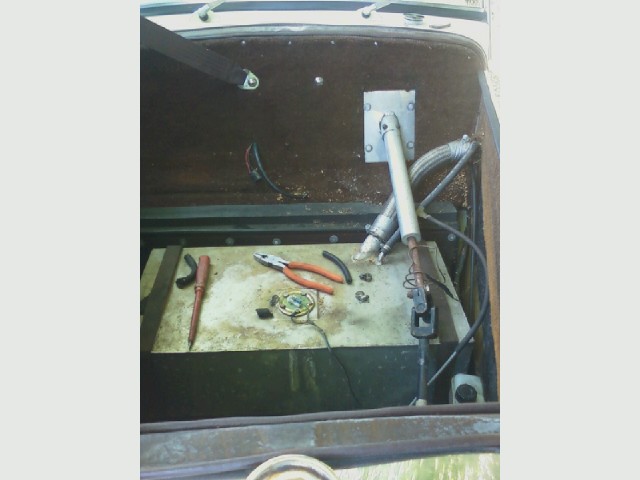
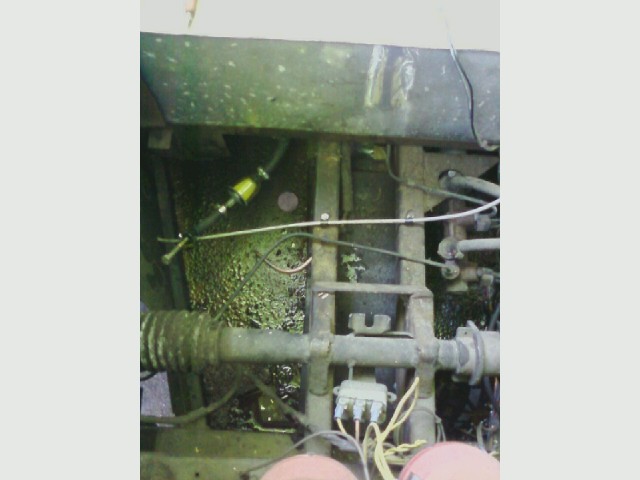 June 5, 2011 at 9:04 pm #244967
June 5, 2011 at 9:04 pm #244967Just a guess, but I suspect the fueling overflowing is partially because the filler pipe ends parallel to the ground (or at least looks like it does in the picture). And looks like it’s only about six inches above the tank.
On my Duchess, the filler pipe ends at the radiator cap. It’s straight down about a foot, then takes a right angle into the front of the tank.
I’ve never had any problem.
PMOSSBERG40699.8789467593
Paul Mossberg
Former Owner of a 1981 Classic Roadsters Ltd. Duchess (VW)
2005 Intermeccanica RoadsterIf you own a TDr and are not in the Registry, please go to https://tdreplica.com/forums/topic/mg-td-replica-registry/ and register (you need to copy and paste the link)
June 6, 2011 at 2:32 am #244968We used a timing light to set the timing this time, and it seems to run better, after readjusting the carburetor. We changed out a rubber valve cover gasket that was leaking with a cork one, made in Germany, but it still leaks a bit. We tried the three different notches in the flywheel and found one that seems best.
So I took it on another test ride tonight. 2-3 miles of surface streets, then onto the Freeway for 10-11 miles. She seemed to run fine at a respectable 60 -65 miles per hour. I got off the freeway, and promptly back on, when as soon as I got up to about 50 mph, she lost power, as if she is not getting fuel. The engine would not restart, so I caught a ride from a friendly citizen to home and towed it home again. Could it be the fuel pump not performing adequately once the engine gets running for a while? Once we got it home, about an hour later, the engine started up again.
I’m going to see if I can find someone to relocate my gas tank filler pipe, but not sure where a better location might be. Someplace higher, maybe an opening somewhere else in the front “trunk”?
MGLondonRoadste40700.1082060185
June 6, 2011 at 5:29 am #244969You might check to see if you have a vented gas cap. If you don’t, after a short period of running you will build a vacuum in the tank and fuel won’t feed. After a period of time air will seep into the tank and it will restart.
June 6, 2011 at 7:51 am #244970And where was the timing set, with all advance in?
June 6, 2011 at 9:46 am #244971I think Dennis may be on to the answer – Richard had the same issue last
year at Carlisle – it would run for a while then lose power and die. His issue
was a plugged up tank at the bottom. I think I would clean out the tank and
make sure your fuel line is clean – blow it out backward w/ compressed air.
Make sure the tank lid is vented or make sure the vent line to the tank is not
plugged – I had that issue myself and it caused your issues. Lastly – I had a
fuel pump do the same thing as well ( a cheap easy fix ). I will check my
pulley and let you know which notch is TDC – also I think the 09 Dist should
be set at about 30 to 32 BTDC at 3000RPM – not at idle – someone can pipe
in here. Good luck and let us know how it goes. You will get it fixed.
Dale
June 6, 2011 at 2:05 pm #244972My car died once, in the early going, for exactly that reason. I swapped out the fuel filter and have not had an issue since. If it persists that POR stuff to coat the tank may be in order.
The idiot book has your timing specs and pictures of the several types of Type 1 pulleys, with the notches. Mine is different–two notches only. But the first one is TDC…(I think).
 June 6, 2011 at 2:51 pm #244973
June 6, 2011 at 2:51 pm #244973The notches are spaced something like this: I I I. We found that it seemed to run best at the middle mark. The one to the right advanced it and the one to the left retarded the timing.
There is a vent for the gas tank, but I didn’t check to see if it might be blocked. You can see the tank vent in one of the photos. The cap is a screw on, but I’m not sure what a vented cap is.
June 6, 2011 at 3:18 pm #244974Mark, I just checked the cap on my London Roadster. There is a hole, about 1/16 ”in diameter,that appears to have been drilled thru the cap . It’s in the slot that is used to remove the cap. I’ve owned the car since 1994 and had not noticed the hole before.If your cap does not have a hole in it,that just may solve your problem.
June 6, 2011 at 3:20 pm #244975I dont’ know if the county emissions folks would allow a hole in the gas cap. Wouldn’t that just vent the gas tank to the outside air?
June 6, 2011 at 3:55 pm #244976Yep. Just like all those cars made before about 1968. You should be emissions exempt.
Best place for the vent hole might be inside the luggege space, on top of the filler neck. Tap in like a 1/8″ tube and extend it up an inch or two (as far as you can), then put a rubber hose on it and route that down to the front wheel well. If you want to get fancy put a charcoal canister on the end of it and vent that to the atmosphere.
June 6, 2011 at 4:16 pm #244977I just checked, and I DO have a small hole in the gas cap, so it is vented. Sure looks a bit off center in the slot, as if someone drilled it after it was made.
What about an overall heat issue? Could the engine heat be heating everything up to cause vapor lock? I’m taking the spare tire off to allow the engine to breath a lot more and then I’ll take her on another test drive now, near the hottest part of today. The fuel filters seem OK, we blew the line backwards and got bubbling in the fuel tank yesterday. I sure hope I don’t break down for an hour in our afternoon sun.
June 6, 2011 at 6:03 pm #244978The test run up the freeway and back, following the same course as last night, without the spare tire mounted, come out clean. No stalls, no engine power loss. The spare tire mount was missing a bolt, so we replaced that right away. We’re going to shim out the tire a few washers worth to pull it away from the fiberglass, hoping to allow more air flow. I would like to find another wire wheel hubcap to put on the spare instead of the slotted steel wheel cover it has now.
June 6, 2011 at 6:41 pm #244979Here is the shot of the rear with the spare tire removed. Are the brackets on other VW TDs also tilted, like mine?
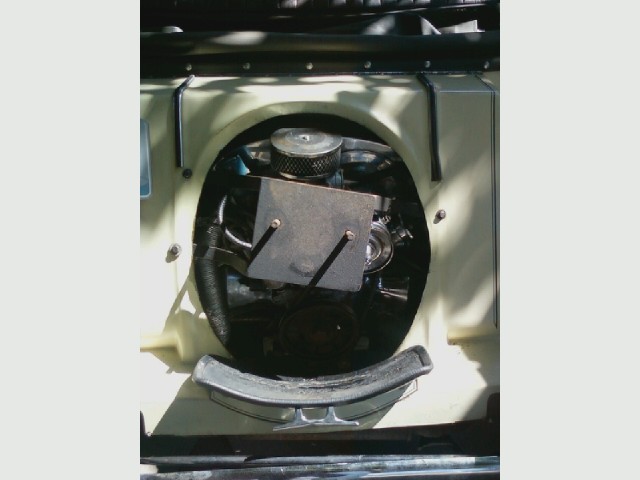
We’re taking the rear most bottom shrouds off, with the theory that the engine needs more “cooler” air so it doesn’t get overheated all around.
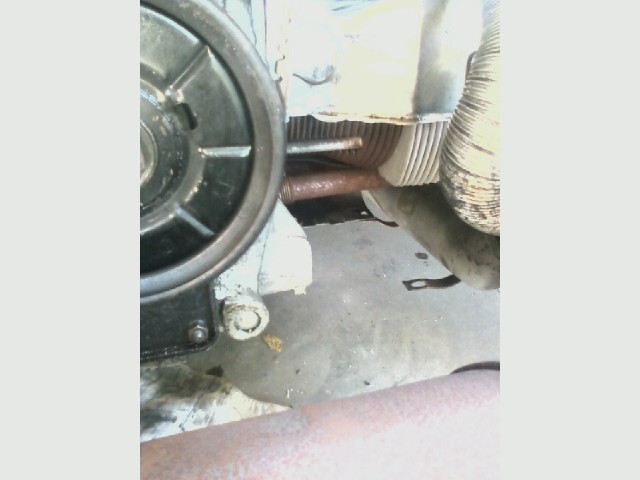
The gap between the spare tire and the rear engine cover, viewed with the cover up. We added a few washers to bring it a little out from the body.
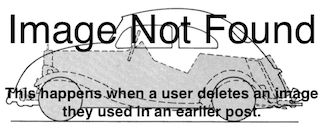 June 6, 2011 at 6:53 pm #244980
June 6, 2011 at 6:53 pm #244980I’d like to replace my wire wheel hub caps/ wheel covers. Should I just search for that item or are there any recommended or favored vendors that someone can recommend. Standard 15 inch.
In the long run, maybe by summer’s end, I’d like to replace the wheels with wire wheels and wider tires. What’s the best way to shop for those, to make sure they will fit my vehicle?
This is what I have now on 4 wheels;
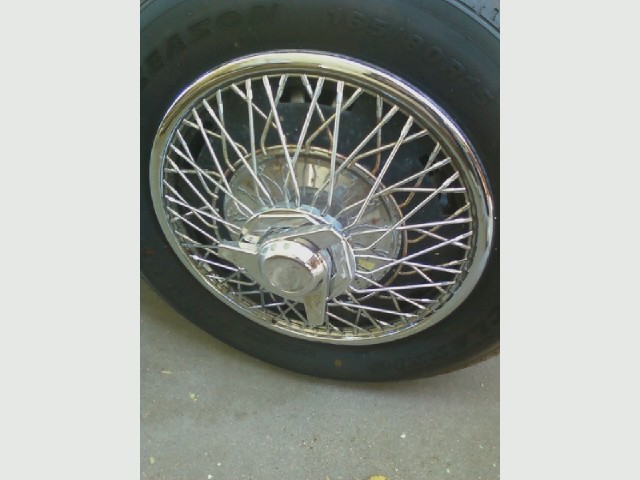
They have a bit of rust one the spokes and rims and I’d like to nice shiny ones.
MGLondonRoadste40700.7878935185
June 6, 2011 at 7:38 pm #244981MGLondon….
For proper cooling, all of the VW engine tin should be in place. The engine doesn’t cool just by air flow in the compartment. The primary cooling is air forced over the heads by the engine fan. All the engine tin is designed to control that air flow and to protect the top end from the exhaust system.
Paul Mossberg
Former Owner of a 1981 Classic Roadsters Ltd. Duchess (VW)
2005 Intermeccanica RoadsterIf you own a TDr and are not in the Registry, please go to https://tdreplica.com/forums/topic/mg-td-replica-registry/ and register (you need to copy and paste the link)
June 6, 2011 at 7:51 pm #244982Starting in May, our Phoenix overall temperatures are much warmer than most other parts of the country (maybe southern New Mexico and west Texas are similar). Our thinking was that the engine heat wasn’t getting out easy enough and as result, recirculating, and heating up the fuel lines, carburetor, and everything, causing a fuel vapor lock and lack of fuel flow once the engine was hot and running for a while. The run without the spare tire in place resulted in no engine stalling or slowing, so we thought that the engine needs more air around it to allow heat to be released. The outside of the engine compartment, including the spare tire and bumper, were way too hot in last nights’ test run, and very touchable after a 20 mile freeway run after when we removed the spare tire. I’m going to wait an hour or so until the rush hour traffic thins out, and take another test run with the spare installed and two metal shroud plates removed.
June 7, 2011 at 10:04 am #244983You must keep the tins in that keep the upper and lower parts of the engine
away from each other – otherwise you will get all the heat from the exhaust
area back into the upper engine area – more heat!
I solved this issue for my car by installing two scoops made from HVAC duct
and ran 3 or 4″ lines up to my front firewall that pushed cool air into the
upper engine area. the scoops are mounted underneath just in front of the
rear wheels. Hope this helps
June 7, 2011 at 11:05 am #244984MGLondon,
Please read the Muir book on timing. You could be overheating because your timing is advanced. A few degrees off can do it. The type one engine is timed statically with a continuity light indicating when the points open. It looks like a pointy screwdriver with a bulb in the handle and a wire at the end of the handle. You time by lining up the correct notch with the centerline of the crankcase. Set points, line up notch, rotate distributor until the light comes on, tighten the hold down bolt. Done.
-
AuthorPosts
- You must be logged in to reply to this topic.
